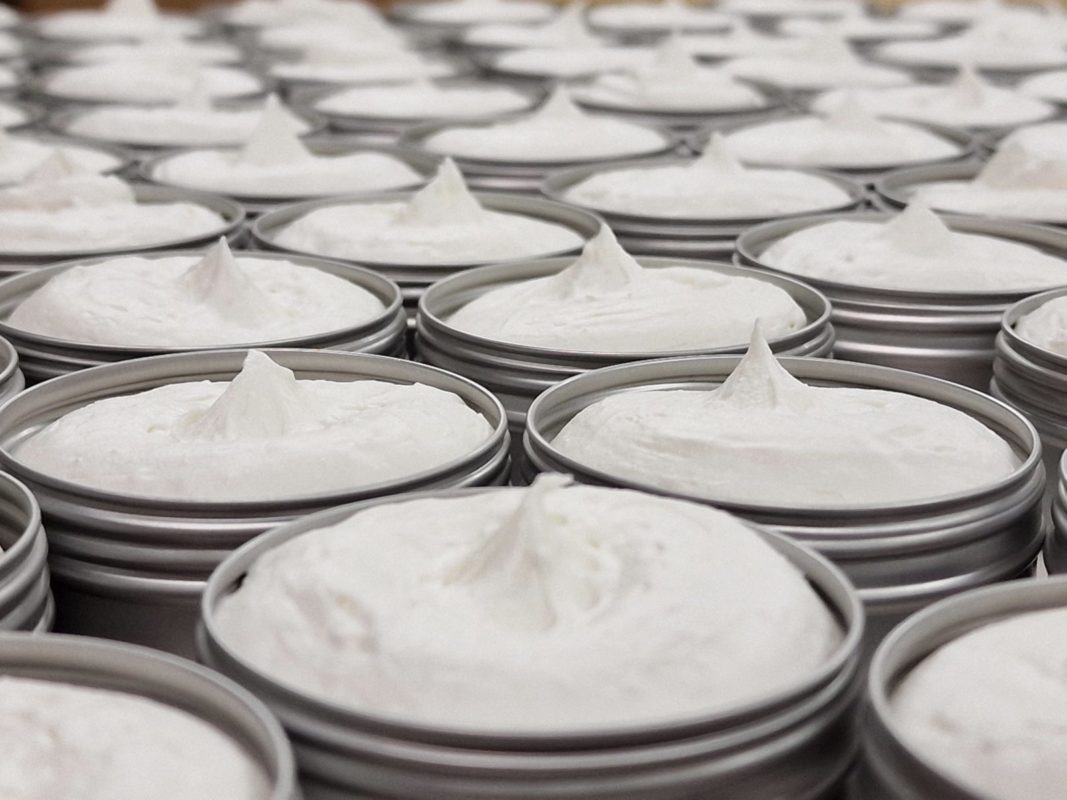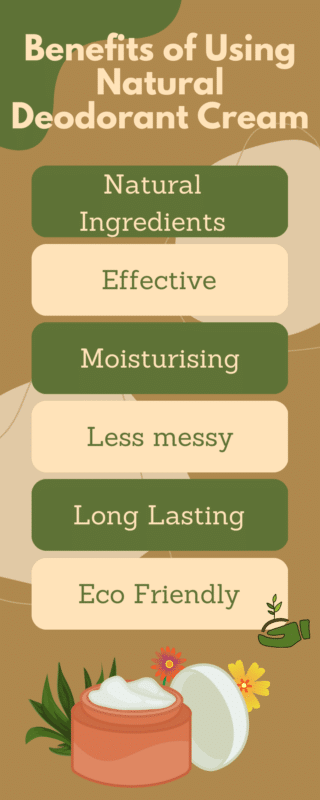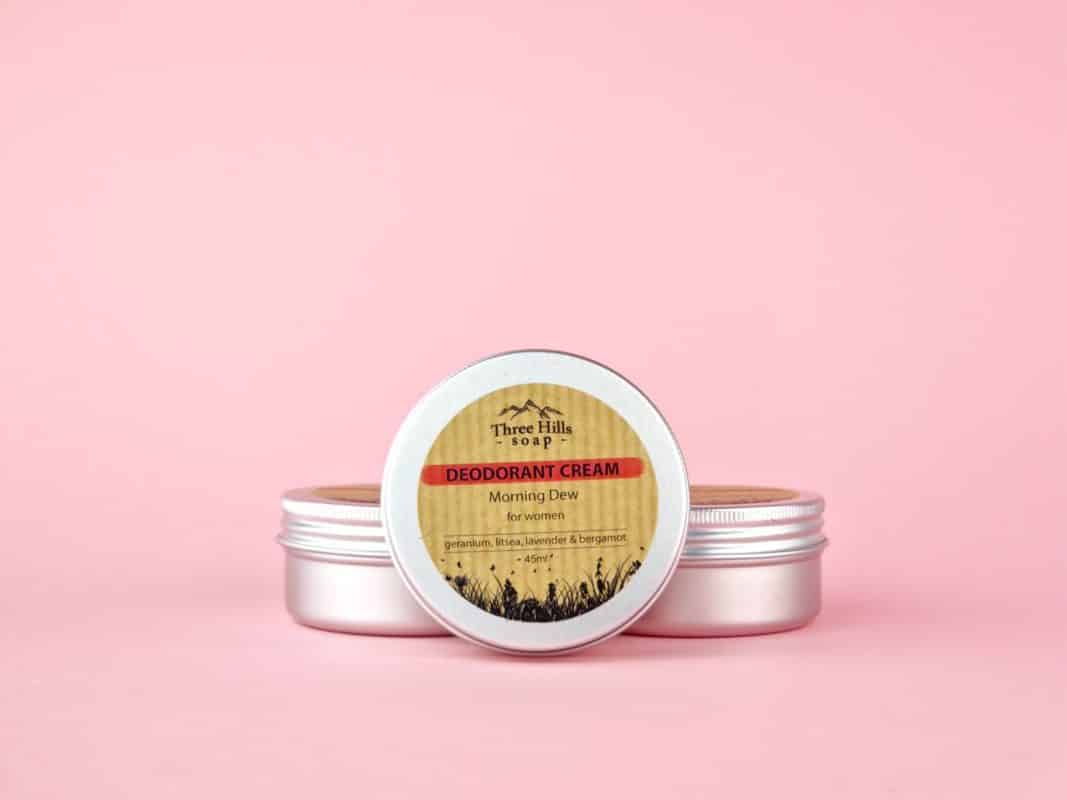Uncategorized
The Ultimate Guide to Deodorant Cream: Everything You Need to Know
The Ultimate Guide to Deodorant Cream: Everything You Need to Know
Estimated reading time: 0 minutes
What is deodorant cream?
Deodorant cream is a popular personal care product used to combat body odour. Unlike traditional deodorants that come in spray or roll-on form, deodorant cream is a semi-solid substance applied directly to the skin. The cream is designed to reduce the production of bacteria that cause bad odour by creating an acidic environment on the skin. Many individuals prefer deodorant cream due to its skin-friendly nature and lack of detrimental substances such as aluminium, which is present in certain conventional deodorants.

How do I use deodorant cream?
Using natural deodorant cream is easy and requires just a few steps. First, make sure your underarms are clean and dry. Then, apply a small amount (pea size is enough) of the cream to your fingertips. Gently rub the cream into your underarms, covering the entire area. The cream should absorb into your skin within a few seconds. Natural deo cream may have a slightly different texture than traditional deodorant, so you may need to experiment with the amount you use to find what works best.
What are the benefits of using deodorant cream?
• Natural Ingredients: Deodorant cream is often made with natural elements like coconut oil, shea butter, and essential oils, making it an excellent choice for people who prefer products with fewer synthetic chemicals.
• Effective: Deodorant cream is as effective as traditional deodorants in controlling odour and reducing sweat. It works by neutralising the bacteria that cause odour.
• Moisturising: The natural ingredients in deodorant cream can moisturise the skin, helping to soothe irritation and prevent dryness.
• Less Messy: Unlike traditional deodorants that can leave a sticky or powdery residue on clothing, deodorant cream is less likely to leave any marks or stains.
• Long-Lasting: Deodorant cream can last several hours, meaning you won’t have to reapply as often throughout the day.
• Eco-Friendly: Deodorant cream typically comes in recyclable packaging and produces less waste than traditional deodorants. This makes it a more eco-friendly choice for people who are concerned about sustainability

What are the active ingredients in deodorant cream?
The active ingredients in deodorant cream can vary depending on the brand and formula, but some common ones include the following:
• Zinc Oxide: offers antimicrobial properties that prevent the growth of odour-causing bacteria, odour absorption to neutralise unpleasant odours, skin soothing as a natural anti-inflammatory, and astringent properties to tighten skin and reduce sweat production.
• Organic Arrowroot Powder: provides absorbent and moisture-wicking properties to keep the underarm area dry and comfortable while offering soothing effects and non-irritating, gentle care for sensitive skin.
• Coconut Oil: Coconut oil has antibacterial properties and can help to moisturise the skin.
• Shea Butter: Shea butter is a natural emollient that can help to soothe and moisturise the skin.
• Essential Oils: Essential oils like lavender, tea tree, and peppermint are often added to deodorant cream for their natural fragrance and antibacterial properties.
It’s important to note that some people may be sensitive to specific ingredients in deo cream. Please always check the label and do a patch test before using a new product.
Is deodorant cream safe to use?
Yes, deodorant cream is generally considered safe to use. Most deodorant creams are made with natural ingredients, which can be gentler on the skin than synthetic chemicals found in some traditional deodorants. However, like any skincare product, it is possible to have an allergic reaction or sensitivity to one or more ingredients. If you have sensitive skin or are concerned about a potential reaction, doing a patch test before using the product is a good idea. Additionally, it’s essential to follow the instructions for use and not apply more than the recommended amount to avoid any potential irritation or adverse effects.
If you do react, stop using the product immediately and consult with a dermatologist for further guidance.
How long does deodorant cream last?
The length of deodorant cream can vary depending on several factors, including the brand, the formula, and how much you apply. Generally, most deo creams can last several hours, and some can protect for up to 24 hours. However, it’s important to note that the deodorant’s effectiveness can also depend on factors like the level of physical activity, the temperature and humidity of the environment, and individual body chemistry.
Does deodorant cream leave white marks on clothing?
Deodorant creams can potentially leave white marks on clothing if they are not fully absorbed into the skin before putting on clothing. However, deodorant creams are less likely to leave visible marks on clothing than deodorant sticks and sprays. This is because deo creams are typically applied using the fingertips and rubbed into the skin, which helps to ensure that the product is fully absorbed and doesn’t transfer onto clothing. Additionally, many deodorant creams are formulated to be less likely to leave white marks on clothing, such as those that contain clear or tinted formulas. However, it’s still a good idea to allow deodorant creams to fully absorb into the skin before getting dressed to minimise the risk of any transfer onto clothing.
Is deodorant cream effective against body odour?
Yes, deodorant cream can be effective against body odour. Deo creams work by neutralising or inhibiting the growth of bacteria on the skin, which is the primary cause of body odour. Deodorant creams typically contain active ingredients such as zinc baking soda and arrowroot or antimicrobial agents like tea tree oil or zinc oxide, which can help to control the growth of bacteria on the skin and prevent body odour.
It’s worth mentioning that the advantages provided by deodorant creams may differ based on the person’s physical activity, diet, and overall health. Some people may find that deodorant creams are more effective than other types of deodorants, while others may prefer different formulations based on their personal preferences and needs.
Can I use deodorant cream on my underarms only?
Yes, you can use deodorant cream on your underarms only. Deo cream is specifically formulated for use on the underarms, as this is typically the area of the body where most people experience body odour. However, deodorant cream can also be used on other areas of the body where you may experience excessive sweating or body odour, such as the feet or groin area.
Does deodorant cream contain aluminium?
Some deodorant creams do contain aluminium as an active ingredient. Aluminium is commonly used in antiperspirant deodorants, including some deodorant creams because it helps to block sweat from reaching the skin’s surface. However, not all deodorant creams contain aluminium. Many aluminium-free deo creams on the market use other active ingredients to control sweat and odour.
If you prefer a deodorant cream that does not contain aluminium, it’s essential to read the ingredients list on the product label carefully. Look for deodorant creams that use alternative ingredients such as baking soda, arrowroot, or natural antimicrobial zinc oxide. These ingredients can help to control sweat and odour without relying on aluminium.
What is the difference between deodorant cream and traditional stick deodorant?
Deodorant cream and traditional stick deodorant are both used to control underarm odour and sweat, but there are some differences between the two:
Formulation: Deodorant cream is a cream-based product typically applied with the fingers, while traditional stick deo is a solid stick applied directly to the skin.
Application: Deodorant cream is applied by scooping a small amount of product onto the fingertips and rubbing it into the skin. Traditional stick deo is applied by gliding the stick directly over the skin.
Ingredients: Deodorant cream and traditional stick deodorant can contain similar active ingredients such as baking soda, arrowroot, or antimicrobial agents, but the formulation and concentration of these ingredients can vary between products.
Coverage: Deodorant cream can provide more thorough coverage of the underarm area because it can be applied more precisely with the fingers. Traditional stick deo may not provide even coverage.
Residue: Deodorant cream is less likely to leave residue on clothing than traditional stick deo, which can leave yellow stains.
The choice between deodorant cream and traditional stick deodorant comes from personal preference and individual needs. Some people may prefer the more natural ingredients and even coverage of deodorant cream, while others may prefer the convenience and familiarity of traditional stick deo.
Does deodorant cream have a scent?
Deodorant creams can have a scent or be unscented, depending on the product. Many deodorant creams are formulated with natural fragrances, such as essential oils, to provide a pleasant aroma and help mask any existing body odour. However, unscented deodorant creams are also available for those who prefer a fragrance-free option.
If you have sensitive skin or allergies, avoid deodorant creams with added fragrances, as they can cause skin irritation or other adverse reactions. Opting for an unscented deodorant cream or a natural, skin-friendly fragrance product may be best.

Can I use deodorant cream for a skin condition like eczema?
If you suffer from a skin condition such as eczema, it’s important to be careful when selecting personal care products, including deodorant creams. While deodorant creams can effectively control underarm odour and sweat, some formulations may contain ingredients that can irritate or exacerbate skin conditions like eczema.
It’s advisable to consult with your dermatologist if you have eczema or any other skin condition before using new personal care products, including deodorant creams. Your dermatologist can help you select a product that is safe for your skin type and provide guidance on how to use it properly.
When using deodorant cream with eczema or other skin conditions, it’s crucial to choose a fragrance-free product that is free of other potential irritants like alcohol or harsh chemicals. Additionally, you should apply the deodorant cream to clean, dry skin and avoid using excessive amounts that may lead to skin irritation or inflammation. If you experience any adverse reactions or worsening of your eczema symptoms, discontinue use and consult with your dermatologist.
Is deodorant cream better for the environment than traditional deodorant?
Deodorant creams may be better for the environment than traditional deodorants in some ways. Here are a few reasons why:
Packaging: Many deodorant creams come in plastic-free or low-waste packaging, such as glass jars or metal tins, which can be more eco-friendly than the plastic packaging used for traditional deodorant sticks.
Ingredients: Some deodorant creams use natural, plant-based ingredients and avoid harmful chemicals, which can be better for the environment and your body.
Production: Because deodorant creams are typically made in small batches by smaller companies, they may have a lower carbon footprint than traditional deodorants produced in large quantities by big manufacturers.
That being said, it’s important to note that not all deodorant creams are created equal, and some formulations may still contain ingredients that are harmful to the environment. Additionally, the environmental impact of a product can also depend on how it is used and disposed of by the consumer. Ultimately, the most eco-friendly choice is to choose a deodorant cream that uses sustainably sourced, natural ingredients and is packaged in recyclable or compostable materials and to dispose of the product responsibly at the end of its use.
Can I apply deodorant cream before or after showering?
Depending on your preference and how your skin reacts to the product, you can apply deodorant cream before or after showering.
If you prefer to apply deodorant cream after showering, it’s important to ensure your underarms are completely dry before using the product. If your skin is still damp, the deodorant cream may not adhere properly, reducing effectiveness.
On the other hand, if you prefer to apply deodorant cream before showering, you can, but remember that the product may be less effective due to the moisture and sweat produced during showering. If you apply deodorant cream before showering, washing your underarms thoroughly with soap and water to remove any residue before showering is a good idea.
Whether you apply deo cream before or after showering depends on your preference and how the product works best for your skin.
How do I know which deodorant cream is best for me?
Choosing a suitable deodorant cream can depend on several factors, including your skin type, activity level, and personal preferences. Listed below are a few pointers that can help you in selecting the deodorant cream for your needs:
Consider your skin type: If your skin is sensitive, choose a deodorant cream that is fragrance-free and formulated with gentle, natural ingredients. You may prefer a deodorant cream that provides extra sweat protection if you have normal or oily skin.
Look for the right ingredients: Deodorant creams can be formulated with various elements, such as baking soda, essential oils, and natural butter. Look for ingredients that effectively control underarm odour and sweat while being gentle on your skin.
Think about your activity level: If you are highly active or participate in sports, you may want a deodorant cream that provides long-lasting protection against sweat and odour.
Check the product reviews: Before purchasing a deodorant cream, read product reviews from other customers to get an idea of how effective the product is and whether it has any potential side effects.
Try different brands and formulations: Everyone’s skin is different, so finding the best deodorant cream may take some time. Try other brands and formulations to find the best one for you.
The best deodorant cream for you depends on your needs and preferences. Consider your skin type, level of activity, and ingredients when choosing a product, and be willing to try different options until you find the one that works best for you.
Can natural deodorant cream prevent sweat?
Natural deodorant cream is formulated to control underarm odour, but it may not be as effective at preventing sweat as traditional antiperspirant deodorants. This is because natural deodorant creams typically do not contain the active ingredients in antiperspirants, such as aluminium, which block sweat glands.
Many natural deodorant creams contain baking soda and arrowroot powder ingredients that can help absorb sweat and moisture. Still, they may not be as effective at controlling heavy sweating as antiperspirants. Instead, natural deodorant creams control the bacteria that cause odour and absorb moisture.
If you are concerned about excessive sweating, consider using a combination of natural deodorant cream and an antiperspirant product. Alternatively, you can look for natural deo creams specifically formulated to provide extra sweat protection. These products may contain magnesium hydroxide or activated charcoal to absorb more sweat and moisture.
Overall, natural deodorant cream can effectively control underarm odour, but it may not provide the same level of sweat protection as traditional antiperspirant deodorants.
Can natural deodorant cream cause skin irritation?
While natural deodorant cream is formulated with gentler, more natural ingredients than traditional antiperspirant deodorants, it can still cause skin irritation in some people. This is because some natural ingredients, such as essential oils or baking soda, can irritate sensitive skin.
Common signs of skin irritation from natural deodorant cream include redness, itching, and a rash. If you experience these symptoms, you must stop using the product immediately and switch to a different deodorant cream or consult a dermatologist.
To minimise the risk of skin irritation, it’s important to choose a natural deodorant cream formulated for sensitive skin and patch test the product before using it regularly. To patch test, apply a small amount of the deo cream to a small area of the skin, such as the inside of your wrist, and wait 24 hours to see if any irritation occurs.
Natural deo cream is a gentler alternative to traditional antiperspirant deodorants but can still cause skin irritation in some people. Be sure to choose a product formulated for sensitive skin and patch test before using it regularly.
Can I use natural deodorant cream while pregnant or breastfeeding?
If you are pregnant or breastfeeding, it’s essential to be cautious about your personal care products, including deodorant cream. While there is limited research on the safety of natural deodorant cream during pregnancy and breastfeeding, some natural ingredients may harm the developing fetus or nursing baby.
For example, some essential oils used in natural deodorant creams, such as tea tree or rosemary oil, may harm the developing fetus and should be avoided during pregnancy. Some natural ingredients, such as baking soda or arrowroot powder, may be safe during pregnancy.
Consult with your healthcare provider before using new products, including natural deodorant cream during pregnancy or breastfeeding. They can provide guidance on which ingredients to avoid and recommend safe alternatives.
Overall, while natural deodorant cream may be a safer option than traditional antiperspirant deodorants for some people, it’s important to be cautious when using any personal care products during pregnancy or breastfeeding.
How do I store natural deodorant cream?
To ensure the longevity and effectiveness of your natural deodorant cream, it’s essential to store it properly. Here are some tips for storing your natural deodorant cream:
Store it in a cool, dry place: Heat and moisture can cause the ingredients in natural deodorant cream to break down, reducing its effectiveness. Store your deodorant cream in a cool, dry place, away from direct sunlight and humidity.
Avoid exposure to extreme temperatures: Natural deodorant cream should not be exposed to extreme temperatures, such as freezing or boiling. Extreme temperatures can cause the product to separate or change texture, making it less effective.
Use a clean applicator: To prevent contamination, use a clean applicator, such as a spatula or your fingertips, to apply the deodorant cream. Avoid using your fingers directly on the deodorant cream to prevent the transfer of bacteria.
How often do I need to reapply natural deodorant?
The frequency of reapplying natural deodorant may vary depending on factors such as your level of physical activity, body chemistry, and the specific brand of deodorant you are using. Natural deodorants generally have a shorter lifespan than traditional antiperspirants due to their lack of harsh chemicals and preservatives.
You may need to reapply natural deodorant every 4-6 hours. However, if you are physically active or live in a hotter climate, you may need to reapply more frequently. Additionally, some natural deodorants may require more frequent application based on their formulation and ingredients.
It’s important to listen to your body and pay attention to any signs of odour or sweat, which may indicate the need for reapplication. You can also experiment with different brands and formulations to find the natural deodorant that works best for you and your individual needs.
Do you put deodorant on before or after the shirt?
Applying deodorant before putting on your shirt is generally recommended to avoid transferring or smudging the deodorant onto your clothing. Additionally, using deodorant to clean and dry skin will allow it to work more effectively throughout the day. Allow the deodorant to dry completely before putting it on your shirt to prevent white marks or stains.
Does the deodorant work during physical activity?
Yes, deodorant can still work during physical activity, but it may not be as effective as during less strenuous activities. When you participate in physical activity, your body temperature rises, and you start to sweat, making it harder for the deodorant to control odour and wetness. However, using a high-quality deodorant with sweat-absorbing properties can help to reduce odour and moisture during physical activity.
It’s important to note that deodorant does not prevent sweating but helps control odour by neutralising the bacteria that cause it. If you are seeking a product that helps to reduce sweating, consider using an antiperspirant, which works by blocking sweat glands. Remember that some natural deodorants may contain ingredients that help reduce sweating, but they may not be as effective as antiperspirants for heavy sweating.
Switching from a traditional deodorant to a natural one may experience a transition period as your body adjusts to the new product. During this time, you should reapply the deodorant throughout the day as needed.
